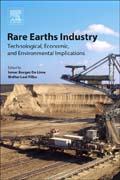
Rare Earths Industry: Technological, Economic, and Environmental Implications
Borges De Lima, Ismar
Leal Filho, Walter
Rare Earths elements are composed of 15 chemical elements in the periodic table. Scandium and yttrium have similar properties, with mineral assemblages, and are therefore referred alike in the literature. Although abundant in the planet surface, the Rare Earths are not found in concentrated forms, thus making them economically valued as they are so challenging to obtain. Rare Earths Industry: Technological, Economic and Environmental Implications provides an interdisciplinary orientation to the topic of Rare Earths with a focus on technical, scientific, academic, economic, and environmental issues. Part I of book deals with the Rare Earths Reserves and Mining, Part II focuses on Rare Earths Processes and High-Tech Product Development, and Part III deals with Rare Earths Recycling Opportunities and Challenges. The chapters provide updated information and priceless analysis of the theme, and they seek to present the latest techniques, approaches, processes and technologies that can reduce the costs of compliance with environmental concerns in a way it is possible to anticipate and mitigate emerging problems. Discusses the influence of policy on Rare Earth Elements to help raise interest in developing strategies for management resource development and exploitationGlobal contributions will address solutions in countries that are high RE producers, including China, Brazil, Australia, and South ChinaEnd of chapter critical summaries outline the technological, economic and environmental implications of rare earths reserves, exploration and marketProvides a concise, but meaningful, geopolitical analysis of the current worldwide scenario and importance of rare earths exploration for governments, corporate groups, and local stakeholders. INDICE: Foreword/Preface Introduction Global Highlights on Rare Earths Rare Earths Exploration: The Worldwide Geopolitical Context and Importance PART I: RARE EARTHS MINING ISSUES 1) Promising geological environments and target areas for rare earth deposits 2) Rare Earths Reserves 3) Extracting Rare Earths of Ores 4) Rare Earth Geochemistry and Ore Dressing 5) Rare Earth Chemistry and hydrometallurgy 6) Rare Earth Magnetic Materials and Magnetism 7) Rare Earth New Materials 8) Rare Earth Catalytic Materials 9) Rare Earth Analytical Chemistry 10) Technological innovations in Sustainable Mining of Rare Earths 11) Wrapping up the Section I 12) The Technological, Economic and Environmental Implications of Rare Earths Mining PART II: RARE EARTHS PROCESSES & HIGH-TECH PRODUCT DEVELOPMENT 13) Rare Earths in Agriculture 14) Metallurgical applications of rare earths: Application of Rare Earths in Iron and Steel; Application of Rare Earth in Casting; Application of Rare Earth in Ceramic and Glass 15) Rare Earths in Magnets & Trends 16) Technologies that require these materials: solar and wind energy systems, hybrid and electric vehicles, high-efficiency lighting, military and aerospace technologies, and most recently, high-efficiency electric motors, smart phones, etc. 17) The Technological, Economic and Environmental Implications of Rare Earths Product Development PART III: RARE EARTHS RECYCLING OPPORTUNITIES AND CHALLENGES 18) Current Rare Earths Recycling Technologies 19) Rare Earths in Magnets & Recycling 20) Green Technology & Rare Earths Recycling 21) Extracting Rare Earth Materials from Nickel-Metal Hydride Batteries 22) Rare Earths recycled from: smart phones, TVs, light bulbs, glass, hybrid and electric vehicle batteries, steel and aluminum wind turbines, etc. 23) Wrapping up the Section III: The Technological, Economic and Environmental Implications of Rare Earths Recycling 24) Conclusion
- ISBN: 978-0-12-802328-0
- Editorial: Elsevier
- Encuadernacion: Rústica
- Páginas: 368
- Fecha Publicación: 01/09/2015
- Nº Volúmenes: 1
- Idioma: Inglés
